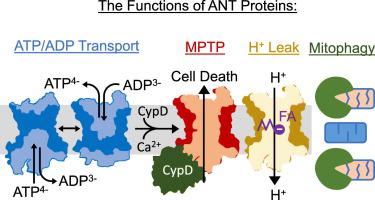Journal of Molecular and Cellular Cardiology ( IF 4.9 ) Pub Date : 2020-05-23 , DOI: 10.1016/j.yjmcc.2020.05.012 Michael J Bround 1 , Donald M Bers 2 , Jeffery D Molkentin 3

|
The adenosine nucleotide translocase (ANT) family of proteins are inner mitochondrial membrane proteins involved in energy homeostasis and cell death. The primary function of ANT proteins is to exchange cytosolic ADP with matrix ATP, facilitating the export of newly synthesized ATP to the cell while providing new ADP substrate to the mitochondria. As such, the ANT proteins are central to maintaining energy homeostasis in all eukaryotic cells. Evidence also suggests that the ANTs constitute a pore-forming component of the mitochondrial permeability transition pore (MPTP), a structure that forms in the inner mitochondrial membrane that is thought to underlie regulated necrotic cell death. Additionally, emerging studies suggest that ANT proteins are also critical for mitochondrial uncoupling and for promoting mitophagy. Thus, the ANTs are multifunctional proteins that are poised to participate in several aspects of mitochondrial biology and the greater regulation of cell death, which will be discussed here.
中文翻译:

ANT在线粒体生物学和坏死细胞死亡中的作用为20/20。
腺苷核苷酸转运蛋白(ANT)家族蛋白是线粒体内膜蛋白,参与能量稳态和细胞死亡。ANT蛋白的主要功能是将胞质ADP与基质ATP交换,从而促进新合成的ATP向细胞的输出,同时为线粒体提供新的ADP底物。因此,ANT蛋白对于维持所有真核细胞的能量稳态至关重要。证据还表明,ANTs构成了线粒体通透性过渡孔(MPTP)的孔形成成分,该结构在线粒体内膜中形成,据认为是调节坏死性细胞死亡的基础。此外,新兴研究表明,ANT蛋白对于线粒体解偶联和促进线粒体也至关重要。从而,











































 京公网安备 11010802027423号
京公网安备 11010802027423号